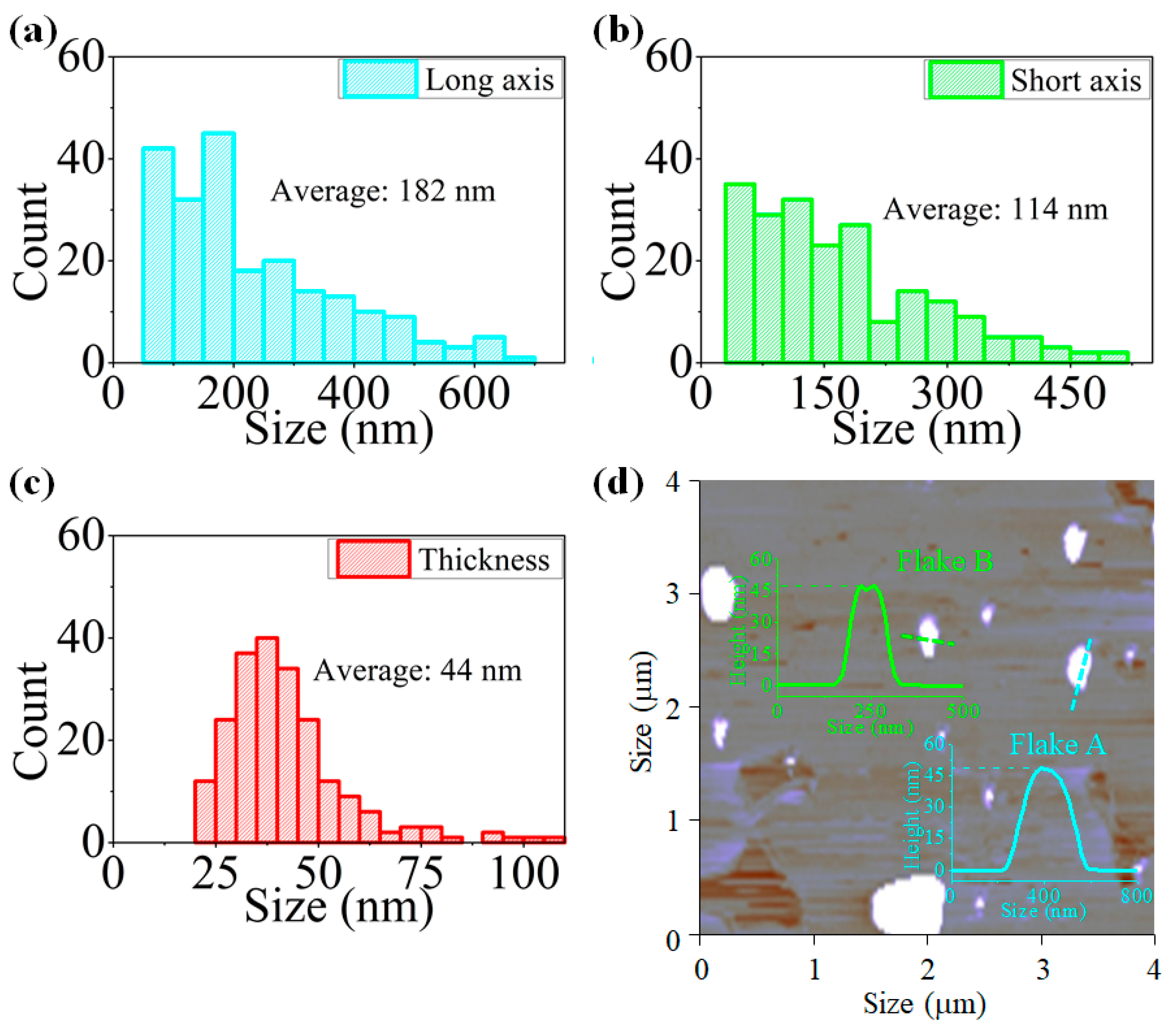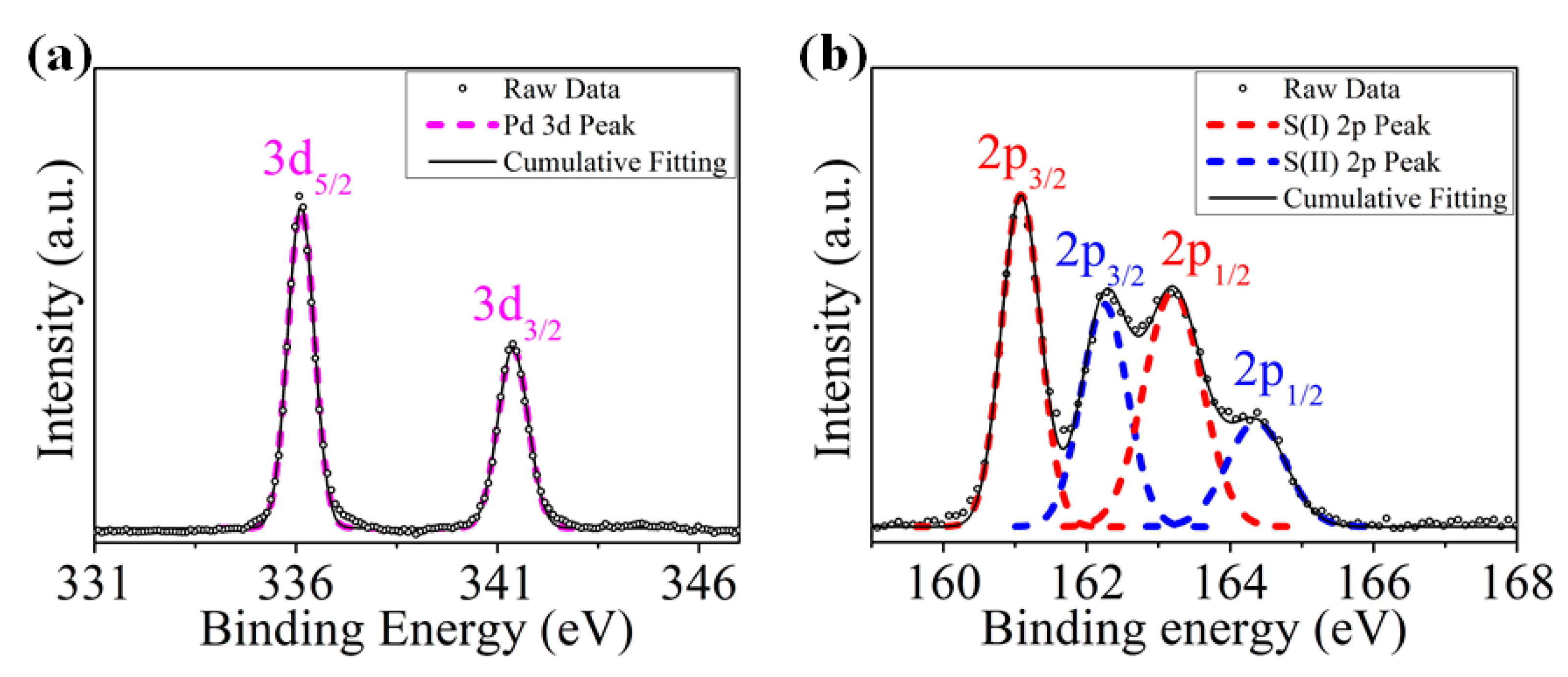Ultrafast Yb-Doped Fiber Laser Using Few Layers of PdS2 Saturable Absorber
Abstract
:1. Introduction
2. Fabrication and Characterization of PdS2
3. Ultrafast Photonics Applications
4. Conclusions
Author Contributions
Funding
Conflicts of Interest
References
- Yue, Y.; Kurokawa, T. Designing responsive photonic crystal patterns by using laser engraving. ACS Appl. Mater. Interfaces 2019, 11, 10841–10847. [Google Scholar] [CrossRef] [PubMed]
- Yin, K.; Yang, S.; Dong, X.; Chu, D.; Gong, X.; Duan, J.A. Femtosecond laser fabrication of shape-gradient platform: Underwater bubbles continuous self-driven and unidirectional transportation. Appl. Surf. Sci. 2019, 471, 999–1004. [Google Scholar] [CrossRef]
- Teuma, E.V.; Bott, S.; Edelhauser, H.F. Sealability of ultrashort-pulse laser and manually generated full-thickness clear corneal incisions. J. Cataract Refract. Surg. 2014, 40, 460–468. [Google Scholar] [CrossRef] [PubMed]
- Boroson, D.M.; Robinson, B.S.; Murphy, D.V.; Burianek, D.A.; Khatri, F.; Kovalik, J.M.; Sodnik, Z.; Cornwell, D.M. Overview and result of the Lunar Laser Communication Demonstration. In Free-Space Laser Communication and Atmospheric Propagation XXVI; International Society for Optics and Photonics: Bellingham, WA, USA, 2014; Volume 8971, p. 89710S. [Google Scholar]
- Wang, W.; Zhao, W.; Huang, L.; Vimarlund, V.; Wang, Z. Applications of terrestrial laser scanning for tunnels: A review. J. Traffic Transp. Eng. 2014, 1, 325–337. [Google Scholar] [CrossRef] [Green Version]
- Assali, P.; Grussenmeyer, P.; Villemin, T.; Pollet, N.; Viguier, F. Surveying and modeling of rock discontinuities by terrestrial laser scanning and photogrammetry: Semi-automatic approaches for linear outcrop inspection. J. Struct. Geol. 2014, 66, 102–114. [Google Scholar] [CrossRef]
- Wang, Y.; Qiu, M.; Won, M.; Jung, E.; Fan, T.; Xie, N.; Chi, S.G.; Zhang, H.; Kim, J.S. Emerging 2D material-based nanocarrier for cancer therapy beyond graphene. Coord. Chem. Rev. 2019, 400, 213041. [Google Scholar] [CrossRef]
- Song, Y.; Shi, X.; Wu, C.; Tang, D.; Zhang, H. Recent progress of study on optical solitons in fiber lasers. Appl. Phys. Rev. 2019, 6, 021313. [Google Scholar] [CrossRef]
- Barmenkov, Y.O.; Kir’yanov, A.V.; Cruz, J.L.; Andres, M.V. Pulse regimes of erbium-doped fiber laser Q-switched using acousto-optical modulator. IEEE J. Sel. Top. Quantum Electron. 2014, 20, 337–344. [Google Scholar] [CrossRef]
- Burgmeier, J.; Waltermann, C.; Flachenecker, G.; Schade, W. Point-by-point inscription of phase-shifted fiber Bragg gratings with electro-optic amplitude modulated femtosecond laser pulses. Opt. Lett. 2014, 39, 540–543. [Google Scholar] [CrossRef]
- Kong, L.C.; Xie, G.Q.; Yuan, P.; Qian, L.J.; Wang, S.X.; Yu, H.H.; Zhang, H.J. Passive Q-switching and Q-switched mode-locking operations of 2 μm Tm:CLNGG laser with MoS2 saturable absorber mirror. Photonics Res. 2015, 3, A47–A50. [Google Scholar] [CrossRef] [Green Version]
- Long, H.; Tang, C.Y.; Cheng, P.K.; Wang, X.Y.; Qarony, W.; Tsang, Y.H. Ultrafast laser pulses generation by using 2D layered PtS2 as a saturable absorber. J. Light. Technol. 2018, 37, 1174–1179. [Google Scholar] [CrossRef]
- Cheng, P.K.; Tang, C.Y.; Wang, X.Y.; Zeng, L.H.; Tsang, Y.H. Passively Q-switched and femtosecond mode-locked erbium-doped fiber laser based on a 2D palladium disulfide (PdS2) saturable absorber. Photonics Res. 2020, 8, 511–518. [Google Scholar] [CrossRef]
- Zhang, L.; Liu, J.; Li, J.; Wang, Z.; Wang, Y.; Ge, Y.; Dong, W.; Xu, N.; He, T.; Zhang, H.; et al. Site-Selective Bi2Te3–FeTe2 Heterostructure as a Broadband Saturable Absorber for Ultrafast Photonics. Laser Photonics Rev. 2020, 14, 1900409. [Google Scholar] [CrossRef]
- Lee, T.H.; Kim, S.Y.; Jang, H.W. Black Phosphorus: Critical Review and Potential for Water Splitting Photocatalyst. Nanomaterials 2016, 6, 194. [Google Scholar] [CrossRef] [Green Version]
- Long, H.; Tao, L.; Tang, C.Y.; Zhou, B.; Zhao, Y.; Zeng, L.; Yu, S.F.; Lau, S.P.; Chai, Y.; Tsang, Y.H. Tuning nonlinear optical absorption properties of WS2 nanosheets. Nanoscale 2015, 7, 17771–17777. [Google Scholar] [CrossRef]
- Liang, G.; Zeng, L.; Tsang, Y.H.; Tao, L.; Tang, C.Y.; Cheng, P.K.; Long, H.; Liu, X.; Li, J.; Qu, J.; et al. Technique and model for modifying the saturable absorption (SA) properties of 2D nanofilms by considering interband exciton recombination. J. Mater. Chem. C 2018, 6, 7501–7511. [Google Scholar] [CrossRef] [Green Version]
- Chen, B.; Zhang, X.; Wu, K.; Wang, H.; Wang, J.; Chen, J. Q-switched fiber laser based on transition metal dichalcogenides MoS2, MoSe2, WS2, and WSe2. Opt. Express 2015, 23, 26723–26727. [Google Scholar] [CrossRef]
- Yan, B.; Zhang, B.; Nie, H.; Li, G.; Sun, X.; Wang, Y.; Liu, J.; Shi, B.; Liu, S.; He, J. Broadband 1T-titanium selenide-based saturable absorbers for solid-state bulk lasers. Nanoscale 2018, 10, 20171–20177. [Google Scholar] [CrossRef]
- Mai, C.; Semenov, Y.G.; Barrette, A.; Yu, Y.; Jin, Z.; Cao, L.; Kim, K.W.; Gundogdu, K. Exciton valley relaxation in a single layer of WS2 measured by ultrafast spectroscopy. Phys. Rev. B 2014, 90, 041414. [Google Scholar] [CrossRef] [Green Version]
- Qiao, J.; Zhao, S.; Yang, K.; Zhao, J.; Li, G.; Li, D.; Li, T.; Qiao, W.; Wang, Y. Sub-nanosecond KTP-OPO pumped by a hybrid Q-switched laser with WS2 saturable absorber and AOM. Opt. Mater. Express 2017, 7, 3998–4009. [Google Scholar] [CrossRef]
- Niu, Z.; Feng, T.; Pan, Z.; Yang, K.; Li, T.; Zhao, J.; Zhao, S.; Li, G.; Li, D.; Qiao, W.; et al. Dual-loss-modulated Q-switched Tm:Ca(Gd,Lu)AlO4 laser using AOM and a MoS2 nanosheet. Opt. Mater. Express 2020, 10, 752–762. [Google Scholar] [CrossRef]
- Liu, W.; Liu, M.; Yang, Y.O.; Hou, H.; Ma, G.; Lei, M.; Wei, Z. Tungsten diselenide for mode-locked erbium-doped fiber lasers with short pulse duration. Nanotechnology 2018, 29, 174002. [Google Scholar] [CrossRef]
- Luo, Z.; Li, Y.; Zhong, M.; Huang, Y.; Wan, X.; Peng, J.; Weng, J. Nonlinear optical absorption of few-layer molybdenum diselenide (MoSe2) for passively mode-locked soliton fiber laser. Photonics Res. 2015, 3, A79–A86. [Google Scholar] [CrossRef]
- Shi, Y.; Long, H.; Liu, S.; Tsang, Y.H.; Wen, Q. Ultrasmall 2D NbSe2 based quantum dots used for low threshold ultrafast lasers. J. Mater. Chem. C 2018, 6, 12638–12642. [Google Scholar] [CrossRef]
- Du, J.; Wang, Q.; Jiang, G.; Xu, C.; Zhao, C.; Xiang, Y.; Chen, Y.; Wen, S.; Zhang, H. Ytterbium-doped fiber laser passively mode locked by few-layer molybdenum disulfide (MoS2) saturable absorber functioned with evanescent field interaction. Sci. Rep. 2014, 4, 6346. [Google Scholar] [CrossRef] [PubMed]
- Samikannu, S.; Sivaraj, S. Dissipative soliton generation in an all-normal dispersion ytterbium-doped fiber laser using few-layer molybdenum diselenide as a saturable absorber. Opt. Eng. 2016, 55, 081311. [Google Scholar] [CrossRef]
- Guoyu, H.; Song, Y.; Li, K.; Dou, Z.; Tian, J.; Zhang, X. Mode-locked ytterbium-doped fiber laser based on tungsten disulphide. Laser Phys. Lett. 2015, 12, 125102. [Google Scholar] [CrossRef]
- Wang, P.; Zhang, H.; Yin, Y.; Ouyang, Q.; Chen, Y.; Lewis, E.; Farrell, G.; Tokurakawa, M.; Harun, S.W.; Wang, C.; et al. NiS2 as a broadband saturable absorber for ultrafast pulse lasers. Opt. Laser Technol. 2020, 132, 106492. [Google Scholar] [CrossRef]
- Yuan, J.; Mu, H.; Li, L.; Chen, Y.; Yu, W.; Zhang, K.; Sun, B.; Lin, S.; Li, S.; Bao, Q. Few-Layer Platinum Diselenide as a New Saturable Absorber for Ultrafast Fiber Lasers. ACS Appl. Mater. Interfaces 2018, 10, 21534–21540. [Google Scholar] [CrossRef]
- Zhang, H.; Ma, P.; Zhu, M.; Zhang, W.; Wang, G.; Fu, S. Palladium selenide as a broadband saturable absorber for ultra-fast photonics. Nanophotonics 2020, 9, 2557–2567. [Google Scholar] [CrossRef] [Green Version]
- Yang, H.; Li, Y.; Yang, Z.; Shi, X.; Lin, Z.; Guo, R.; Xu, L.; Qu, H.; Zhang, S. First-principles calculations of the electronic properties of two-dimensional pentagonal structure XS2 (X = Ni, Pd, Pt). Vacuum 2020, 174, 109176. [Google Scholar] [CrossRef]
- Deng, S.; Tao, M.; Mei, J.; Li, M.; Zhang, Y.; Li, L. Optical and Piezoelectric Properties of Strained Orthorhombic PdS2. IEEE Trans. Nanotechnol. 2019, 18, 358–364. [Google Scholar] [CrossRef]
- Lan, Y.S.; Lu, Q.; Hu, C.E.; Chen, X.R.; Chen, Q.F. Correction to: Strain-modulated mechanical, electronic, and thermal transport properties of two-dimensional PdS2 from first-principles investigations. Appl. Phys. A 2019, 125, 107. [Google Scholar] [CrossRef] [Green Version]
- Asl, M.G.; Kuc, A.; Miro, P.; Heine, T. A single-material logical junction based on 2D crystal PdS2. Adv. Mater. 2016, 28, 853–856. [Google Scholar]
- Wang, X.; Qarony, W.; Cheng, P.K.; Ismail, M.; Tsang, Y.H. Photoluminescence of PdS2 and PdSe2 quantum dots. RSC Adv. 2019, 9, 38077–38084. [Google Scholar] [CrossRef] [Green Version]
- Saraf, D.; Chakraborty, S.; Kshirsagar, A.; Ahuja, R. In pursuit of bifunctional catalytic activity in PdS2 pseudo-monolayer through reaction coordinate mapping. Nano Energy 2018, 49, 283–289. [Google Scholar] [CrossRef]
- Kristin, P. Materials Data on PdS2 (SG:61) by Materials Project; DOE Data Explorer: New York, NY, USA, 2014. [Google Scholar] [CrossRef]
- Cavalleri, O.; Gonella, G.; Terreni, S.; Vignolo, M.; Pelori, P.; Floreano, L.; Morgante, A.; Canepa, M.; Rolandi, R. High resolution XPS of the S 2p core level region of the L-cysteine/gold interface. J. Phys. Condens. Matter 2004, 16, S2477. [Google Scholar] [CrossRef]
- Dodero, G.; De Michieli, L.; Cavalleri, O.; Rolandi, R.; Oliveri, L.; Dacca, A.; Parodi, R. L-Cysteine chemisorption on gold: An XPS and STM study. Colloids Surf. A Physicochem. Eng. Asp. 2000, 175, 121–128. [Google Scholar] [CrossRef]






| Group of Transition Metal | Material | Wavelength, nm (3 dB Bandwidth, nm) | Pulse Duration (SNR, dB) | Slope Efficiency (Output Power, mW) | Reference |
|---|---|---|---|---|---|
| Group 5 | NbSe2 | 1033 (0.155) | 380 ps (43) | 3.70% (10.5) | [25] |
| Group 6 | MoS2 | 1042.6 (8.6) | 656 ps (59) | 1.1% (2.37) | [26] |
| MoSe2 | 1040 (4.26) | 471 ps (54) | / (2.0) | [27] | |
| WS2 | 1030.3 (1.1) | 2.5 ns (48) | 2.5% (8.02) | [28] | |
| Group 10 | NiS2 | 1064.5 (7.8) | 11.7 ps (66) | 5.1% (35.6) | [29] |
| PtSe2 | 1064 (2.0) | 470 ps (53) | 3.6% (12.19) | [30] | |
| PdSe2 | 1067.4 (5.22) | 768 ps (61) | 4.6% (15.6) | [31] | |
| PdS2 | 1033 (3.7) | 375 ps (65) | 4.99% (15.7) | This work |
Publisher’s Note: MDPI stays neutral with regard to jurisdictional claims in published maps and institutional affiliations. |
© 2020 by the authors. Licensee MDPI, Basel, Switzerland. This article is an open access article distributed under the terms and conditions of the Creative Commons Attribution (CC BY) license (http://creativecommons.org/licenses/by/4.0/).
Share and Cite
Cheng, P.K.; Liu, S.; Ahmed, S.; Qu, J.; Qiao, J.; Wen, Q.; Tsang, Y.H. Ultrafast Yb-Doped Fiber Laser Using Few Layers of PdS2 Saturable Absorber. Nanomaterials 2020, 10, 2441. https://doi.org/10.3390/nano10122441
Cheng PK, Liu S, Ahmed S, Qu J, Qiao J, Wen Q, Tsang YH. Ultrafast Yb-Doped Fiber Laser Using Few Layers of PdS2 Saturable Absorber. Nanomaterials. 2020; 10(12):2441. https://doi.org/10.3390/nano10122441
Chicago/Turabian StyleCheng, Ping Kwong, Shunxiang Liu, Safayet Ahmed, Junle Qu, Junpeng Qiao, Qiao Wen, and Yuen Hong Tsang. 2020. "Ultrafast Yb-Doped Fiber Laser Using Few Layers of PdS2 Saturable Absorber" Nanomaterials 10, no. 12: 2441. https://doi.org/10.3390/nano10122441
APA StyleCheng, P. K., Liu, S., Ahmed, S., Qu, J., Qiao, J., Wen, Q., & Tsang, Y. H. (2020). Ultrafast Yb-Doped Fiber Laser Using Few Layers of PdS2 Saturable Absorber. Nanomaterials, 10(12), 2441. https://doi.org/10.3390/nano10122441







